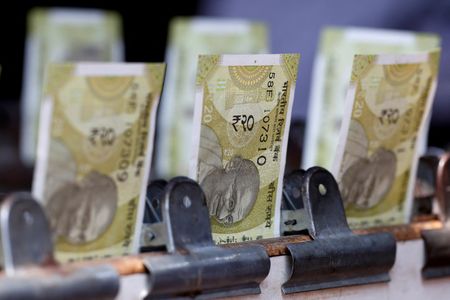By Jaspreet Kalra and Nimesh Vora
MUMBAI (Reuters) – The Indian rupee slumped to a fresh all time-low and logged its biggest single-day decline in nearly two years on Monday, bogged down by a surging U.S. dollar, likely outflows from local equities and limited intervention from the central bank.
The rupee declined to 86.5825 before ending the session at 86.5750, down 0.7% on the day. The last time it fell this much was in February 2023.
The local currency has declined over 2% since December on worries over India’s slowing growth and expectations that central bank may cut rates as soon as February.
“The rupee’s slide can continue for some time as negative factors have stacked up quite a bit unless the central bank announces some measures,” said Anshul Chandak, head of treasury at RBL Bank.
Chandak reckons the 87 handle is “just around the corner,” for the rupee and expects the Reserve Bank of India (RBI) to use its diminished reserves “cautiously.”
India’s foreign exchange reserves dropped to $634.6 billion in the week through Jan. 3, an over 10-month low, and down $70 billion from a peak hit in late September.
The country’s FX reserves saw the biggest drawdown in percentage terms in Asia in December, as per Nomura’s calculations.
The RBI has been intervening to slow down the rupee’s decline, selling dollars in the spot and the forward market.
The RBI sold dollars on Monday, but less aggressively than previous episodes of sharp rupee weakness, traders said.
GLOBAL PRESSURES
The rupee’s weakness is in line with Asian currencies, which were struggling on the heels of the dollar index climbing to an over two-year peak.
The U.S. economy added more jobs than expected in December, reinforcing expectations that borrowing costs in the U.S. will likely remain higher for longer, boosting the dollar and pushing U.S. Treasury yields to multi-month highs.
The dollar has been rallying in the lead up to U.S. President-elect Donald Trump’s inauguration on Jan. 20.
Higher U.S. yields have prompted investors to exit riskier assets, sending the benchmark Indian equity indexes, the BSE Sensex and the Nifty 50, down 1.2% each on Monday.
Foreign investors are exiting their Indian investments and have sold over $4 billion of domestic stocks and bonds in January so far.
(Reporting by Jaspreet Kalra and Nimesh Vora; Editing by Mrigank Dhaniwala, Sonia Cheema and Janane Venkatraman)












